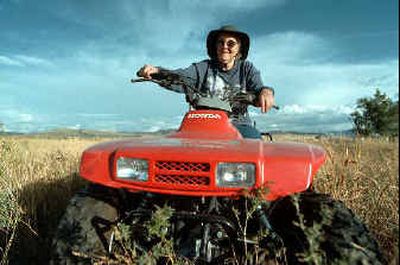NO HEADLINE

The good news started in 1939, when Washington created its first “game refuge,” now the Sinlahekin Wildlife Area in northern Okanogan County.
Recognizing that deer, elk and other wildlife need large stretches of habitat, the state began buying land along Sinlahekin Creek in the foothills east of the Cascades. The purchases were funded largely by federal excise taxes on hunting gear.
Since then, Washington has secured dozens of state-managed areas, from estuaries to scablands, managed especially for wildlife and in most cases for wildlife recreation, including hunting.
A hunter interested in big-game, upland birds, waterfowl and other species including wild turkeys could spend all fall just getting his bearings in the headliner areas of far-Eastern Washington. Here’s a sampling of where to start.
Swanson Lakes Wildlife Area south of Creston sprawls over 19,000 acres of scablands and potholes in Lincoln County. Game species include mule deer, pheasants, California quail and Hungarian partridge as well as waterfowl. The area also holds sharp-tailed grouse, which are a protected species and not legal to hunt.
Sherman Creek Wildlife Area on the west side of Lake Roosevelt and south of U.S. Highway 20 covers nearly 10,000 acres in Ferry County. The area is rugged, including rock outcrops and cliffs, plus two streams. Game species include white-tailed deer and waterfowl. The state releases pen-raised pheasants here periodically during the hunting season.
Wooten Wildlife Area along the Tucannon river south of Pomeroy covers 11,778 acres in Columbia and Garfield counties. This rugged area of the Blue Mountains is primarily a winter range for deer and elk, but also offers some hunting for these species as well as for turkeys. The area also has lakes stocked with trout.
Asotin Creek Wildlife Area west of Asotin in Asotin County covers 13,815 acres ranging from streamside elevations of 1,800 feet to high ridges in the Blue Mountains at 4,600 feet. It’s important elk winter range, but offers hunting for elk and deer, as well as upland birds, mountain grouse and turkeys. Bighorn sheep also are found.
Grouse Flats Wildlife Area about 70 miles southwest of Clarkston covers 640 acres in Garfield County. Elk and deer are attracted to 200 acres of hay fields planted just for them. Other game animals include bear, cougar, mountain grouse and turkeys.
Chief Joseph Wildlife Area in the lower Grande Ronde River drainage includes 9,735 acres in Asotin County. Elevations range from 825 feet to 4,913 feet at Mt. Wilson, the highest point in the vicinity. Game animals include bears, bighorn sheep, elk, deer, wild turkeys, upland birds and grouse.
Desert Wildlife Area west of Moses Lake includes 35,100 acres in Grant County. The desert has numerous water sources created by runnoff from the Columbia Basin Irrigation Project, making it one of Washington’s most important waterfowl breeding grounds. Game birds including pheasant, chukar and Hungarian partridge, and quail. The area is known for producing trophy mule deer bucks in permit hunts.